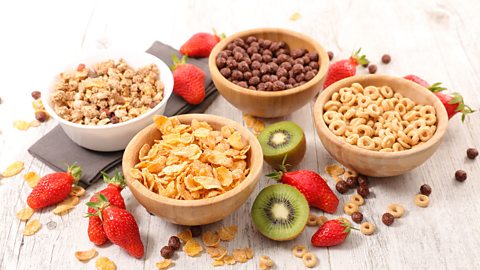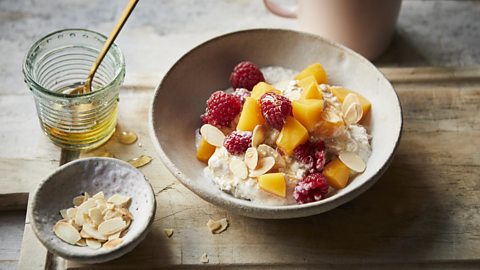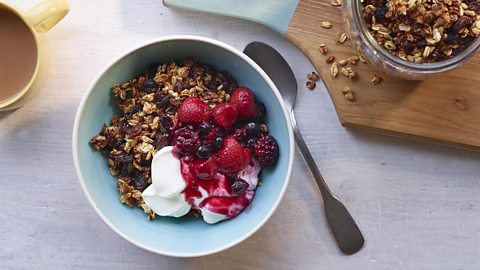How to choose (and make) breakfast cereals that are actually good for you
By Sue Quinn
Britain is a nation of cereal lovers, ploughing through nearly 500 million kilograms of the stuff . But do we pay enough attention to the ingredients in our favourite box? Hereâs how you can make sure youâre buying â and making â cereals that will give your mind and body the best start to the day.

Breakfast cereal: itâs quick, convenient and according to Euromonitor International, in the UK, we spend more on it per head than most other countries. But despite its popularity, breakfast cereal has come under fire in recent years for the high sugar content of some varieties and the way theyâre marketed.
A recent report by the found that 93 percent of breakfast cereals aimed directly at children contain high or medium levels of sugar.
Kelloggâs Fruit Loops Marshmallows has the most, according to the report, with 17g per 39g portion (4 teaspoons). That accounts for 89 percent of the maximum recommended daily intake of âfree sugarsâ â all added sugars in any form â for a child aged between four and six.
Overall, the report found no significant improvement in the sugar content of breakfast cereals marketed to children in the past year, although there has been some progress in lowering salt and increasing fibre content.
âBreakfast cereals and yoghurts are foods that parents are often likely to give their children in the belief that they are a relatively healthy option,â the report says. âMany of these products are marketed directly towards children (e.g. child-friendly branding, colours and style; or childrenâs activities and prizes included) but fall short on their nutritional credentials.â
As part of its policy to tackle the obesity crisis, the government is introducing new rules from October preventing cereals and other products high in fat, salt or sugar to be prominently displayed in stores. (A ban on promotions such as buy-one-get-one-free offers has been delayed for 12 months because of the cost-of-living crisis.)
But how do you choose the healthiest cereal option in the first place?
Confusing messaging
Breakfast cereals can be part of a healthy balanced diet, experts say. Many are a good source of wholegrain (which helps protect against disease), fibre (essential for a healthy digestive system), vitamins, minerals and other nutrients. But the messaging on cereal packs can make it difficult to know which ones are the healthiest.
Thereâs no legal definition of breakfast cereal, says Dr Rana Conway, a registered nutritionist and member of the at University College London. But manufacturers use the term âcerealâ on packaging to encourage us to think the product is healthy when this isnât necessarily the case.
âYou could market anything as breakfast cereal,â Dr Conway says. âIn fact, you see some breakfast âcerealsâ that are really just sugary biscuits.â
Cereal packs often feature health claims, such as the presence of calcium and the addition of nutrients like iron, vitamin D and folic acid. Some of these nutrients have been lost during milling, cooking and processing and are added back in using a method known as fortification. Other terms such as âadded goodnessâ and illustrations of grains or sheaves of wheat suggest in a non-specific way that the cereal inside is good for us.
âManufacturers do this to create a health halo effect, so we think itâs a healthy food,â Dr Conway says. âLots of cereals are fortified with iron, vitamin D and folic acid and so on. But that doesnât compensate for the really high sugar content of some of them.â
The term âwholegrainâ can be misleading, too. To carry the label, a product must contain the entire edible part of the grain: the germ, endosperm and bran. But the UK doesn't have a when it comes to the amount a product needs in order to be promoted as âwholegrainâ.
âThe thing to be careful about is seeing 'wholegrain' on the front of a pack and thinking that means it's healthy,â Dr Conway says. âIt could still have lots of sugar.â
The only way to know for certain what a breakfast cereal contains, and the amount of healthy ingredients it has compared to unhealthy, is to examine the carefully. And itâs important to remember this won't include the milk you pour on your cereal.
Portion sizes
The nutrition label on cereal packs often displays the sugar, fat, fibre, salt and other nutrients per serving in a column next to the . However, Bahee Van de Bor, a registered dietitian and spokesperson for the British Dietetic Association (BDA), says the most important information is found in the âper 100gâ column.
Serving sizes suggested on packs are decided by manufacturers and are based on average consumption across nine European counties including the UK. Suggested portions range from 30g to 45g, according to the density of the cereal (puffed rice is less dense than muesli, for example).
The thing is, these portions donât accurately reflect what every person eats, Van de Bor says. If you consume more than the suggested amount, your sugar intake will be much higher than the pack suggests. Checking the sugar, fat, salt and fibre per 100g column is far more helpful.
A spokeswoman for Kellogg's tells us serving sizes were not designed to mislead consumers about sugar content. âWhile we can give recommended portion information, we canât control consumer behaviour,â she says.
Although voluntary, the traffic light system â a label with red, amber and green colour coding â now appears on most cereals packs to tell you at a glance if the food has high, medium or low amounts of fat, saturated fat, sugars and salt. (Red means high, amber means medium and green means low.) Again, check that this shows the amount of salt, fat, sugar and fibre per 100g as opposed to per serving.
Also check the list of ingredients, which is ordered by weight. âIf the first few ingredients are sugar, honey or syrups, itâs a clue that the cereal is likely to be high in sugar,â Van de Bor says. âAssessing the per 100g column will confirm this.â
Look out for wholegrains in the ingredients list, too. âYou want to see wholegrains right at the top. Nuts and seeds are also great, because most of us donât include enough of those in our diet,â Dr Conway says.
When buying cereal for children, take care when reading , which often appear as percentages in a column on the nutrition label. RIs are amounts of particular nutrients and energy required for healthy adults, and the percentage shows the contribution the product makes to those intakes. However, even on products for children, RI values are based on adult requirements.
âChildren of different ages obviously have varying energy and nutrient requirements, and the maximum sugar levels for children are lower than those for adults,â Dr Conway explains. âIf you see a percentage RI on cereal, this underestimates the calories and sugar that children will get, relative to their requirements. I think it's fair to say that's misleading.â
Healthy choices

So, whatâs the healthiest cereal option? Porridge made with milk or water is the top choice of . Alternatively you could make overnight oats in advance, using porridge oats.
All porridge oats are made from healthy wholegrains, but go for large oats rather than the finely ground, quick-cook variety, Dr Conway advises.
âIf itâs ground up or highly processed, the nutrients can be quickly converted to sugar and go straight to your blood sugar levels. The instant kinds often contain syrups or other sweeteners, too.â
Low-sugar cereals (containing less than 5g per 100g), such as those made from shreds or flakes of wheat, are good choices. The types made from bran flakes are also healthy, especially if they contain dried fruit, as this can count towards your five-a-day, Dr Conway says. âI would definitely avoid anything with 'honey' in the name or anything thatâs frosted â that essentially means high sugar,â she adds.
But before buying, do check the nutrition information and ingredients list to see the . You will find different brands of cereals, such as bran flakes, contain different amounts of added sugar - they might contain more than you'd think.
Many people believe muesli and granola are healthy because they contain wholegrains, dried fruit, nuts, and seeds. But opt for packs containing no added sugar or salt. Remember added or âfreeâ sugar can take the form of honey, syrups, nectars and anything ending in âoseâ, such as .
Make your own

Registered nutritionist Katherine Kelly says there are simple ways to make any cereal healthier. âBreakfast should be high in fibre, nutrients and , so if your cereal is lacking, add a tablespoon of mixed seeds,â she suggests. âThis could be ground seeds, such as flax seeds, or whole seeds like pumpkin, sunflower or chia seeds.â
For sweetness, add fresh fruit instead of sugar â frozen berries, thawed, are a tasty and economical option, and dried fruit also works well. A spoonful of plain or coconut yoghurt makes a nutritious topping, too. âYouâll get some live bacteria from those which is good for your gut microbiome,â Kelly says.
Another idea is to mix a less healthy breakfast cereal with oats or another sugar-free variety. Or make your own from scratch. Mix oats with your favourite nuts, seeds and dried fruit for homemade muesli. Or combine the same mixture with melted coconut oil, spread it out on a baking tray and lightly toast to make granola.
Finally, if you eat breakfast cereal most days, consider swapping your regular bowlful for something savoury now and then. âStarting the day with a sweet breakfast is obviously not ideal for adults or children,â Dr Conway says. âConsider savoury options like eggs. Or a piece of toast with peanut butter and a side of fruit isnât a big effort and would make a perfect breakfast.â
Originally published August 2022.